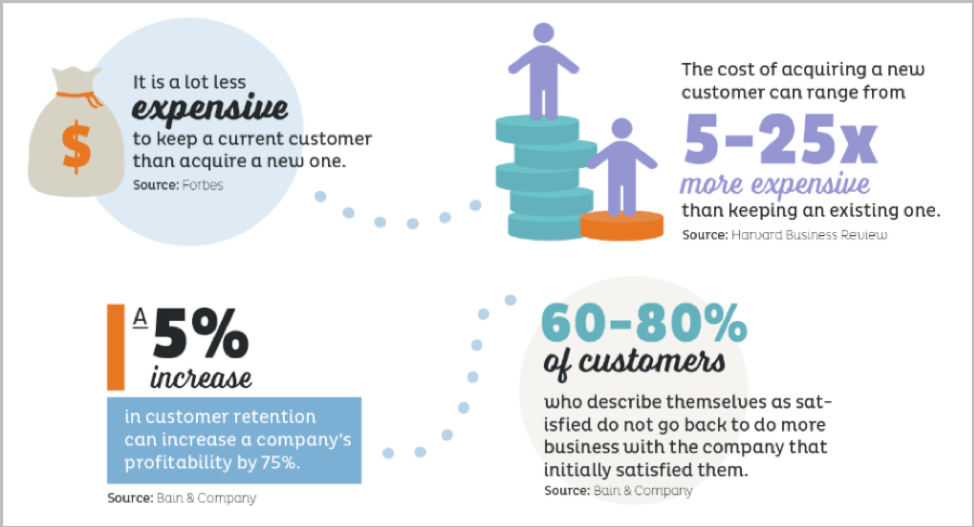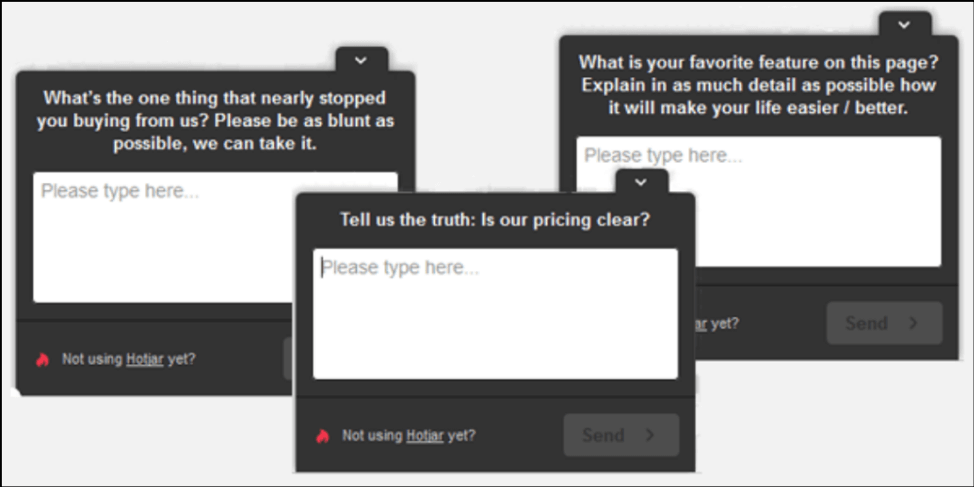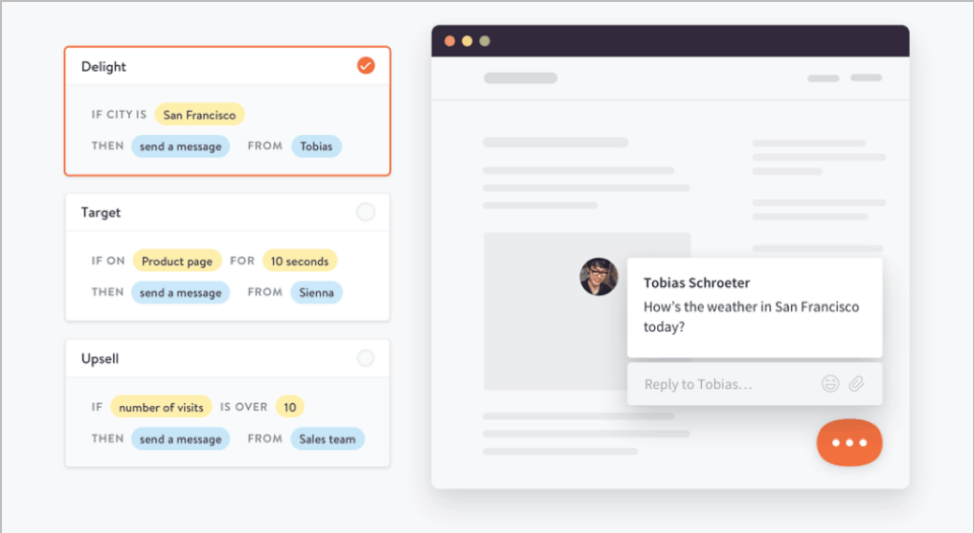Answering the real questions your customers are asking can form an important part of your customer retention plan.
Customers have questions. You have answers — or so they hope! By leaving any key questions unanswered, you risk:
- Your prospects bailing out of your lead generation and sales funnels.
- Your customers feeling like you know and care about them, and thus looking to do their business elsewhere.
- Your bottom line revenues showing the effects of your customer neglect.
But by discovering these questions and addressing them proactively, you’ll stay one step ahead of your competition.
Now that we’ve established why it’s important to actively discover the top questions being asked — or thought of — by your prospects and customers, let’s dive into how to discover them.

Begin by discovering customer questions
A recent Harvard Business Review article states that acquiring a new customer is anywhere from five to 25 times more expensive than retaining an existing one. So, clearly, defining your customer retention plan is your first order of business.
Who knows your customers best? The people who speak with dozens of them on a daily basis: your customer service reps (CSRs).
Speak with customer support reps (CSRs)
If you haven’t spoken with your CSRs in a while (or ever), get in touch with them this week. After they get over the shock that you actually asked them for their input, they’ll likely be eager to share what they’re hearing from customers on a daily basis.
After first meeting with the Support Supervisor to explain your intent and get their permission to speak with reps on their team, set 30-minute time slots with groups of CSRs and ask them:
- What are the three to five top customer complaints/issues you hear on a regular basis?
- What do you feel are the top underlying reasons for these issues?
- Which issues do you feel are most important to fix ASAP?
- How would fixing these issues a) improve customers’ lives and b) improve your lives?
So that these sessions aren’t just a ‘gripe fest,’ also ask, preferably in a follow-up chat:
- What ideas do you have for fixing the issues you mentioned earlier? (be sure to document and share this ‘issues list’ before this session).
- What other ideas do you have for improving the process of providing customer support?
While these are simple questions, don’t expect simple answers in return. Be patient, don’t interrupt, and keep the insights coming. You might want to record the conversation so you can refer back to it later, which is easy to do with online video conference tools.
Analyze your phone and chat log data
Talking to your support reps is a great start. But, if you want to discover the ‘deep truth’ about why some of your customers aren’t fully satisfied, you’ll need to dig deeper.
Get access to agent-customer data for your top customer touchpoints: chat, phone, and Web.
For chat and phone, review support calls to see which themes keep coming up, and how your team has been handling them (or not).
For Web, you should already know to review your high-level web analytics. But don’t stop there! Go further by drilling into analytics by things like customer segment (configured in your analytics app), customer intent (as inferred by top keywords), and key demographic criteria (things like age, income, etc.).
Look for causes of customer churn
If you run a subscription business, analyze what causes your customers to churn (terminate their subscriptions). If you run an e-commerce store, identify where your customers’ expectations aren’t being met. As with any customer analysis, don’t just skim the surface; drill down far enough to identify the ‘root cause’ issues.
After hypothesizing about your customers' reasons for bailing out, run some tests or adjust some operational processes to address these issues. Then document your learnings and results in your customer retention plan.

Automate your digging for root causes
If you don’t fear automation, consider using ‘text mining’ or ‘semantic analysis’ apps to do the hard work of analyzing the conversations happening on your chat and phone channels.
As this Smart Insights article details, many of these apps include the ability to automatically discover souring sentiment.
Take it to the next analytics level: use predictive analytics apps
The best businesses don’t just address customer questions, they anticipate them. And thankfully, in the current era of analytics technology, you don’t need to be a mind reader.
Predictive analytics apps and algorithms can, assuming that you feed them enough ‘seed’ and ongoing customer data, glean things like:
- Whether a customer is likely to buy again, and what they'll most likely buy.
- A given customer’s top questions and concerns.
- A customer’s impression of your brand.
- Last issue resolution status - if the customer experienced an issue, how quickly and fully it was resolved.
These analytics apps will show you these indicators in a succinct dashboard view, so that you (or your analytics lead) won’t get lost in analysis space.
Move on to discovering prospect questions
After you’ve addressed your top customer issues, you can start looking ‘upstream’ to the questions asked by your prospects.

Run a one-question poll
Who doesn’t like a good survey? Well, I don’t, for one. The problem with surveys: they are too long, interruptive and suffer from too many response biases. So don’t just serve up survey pop-ups on your website.
Instead, create one-question polls tailored to particular places in your online experience. Then push them to your visitors at the appropriate time and place.
For example, if you want to make sure you understand prospect intents, create an ‘entry intent” survey. On your homepage and/or landing pages, ask:
‘Hi! Quick question: What’s the main thing you want to find during your visit today?
If you already know this from other analyses, focus more on clarifying mid-funnel questions with an ‘objections identification’ poll. For example, if you see that a particular visitor is stalled on a product page for more than 40 seconds, you might ask:
‘Hi! Quick question: What questions or concerns about keeping you from buying today?’
You get the idea - single questions, tailored your question-identification goal at that exact point in your prospect’s experience.
Deploy a good chat experience
To this day, I am amazed at how many businesses in 2019 either:
- Don’t offer an online chat experience or
- Have a woefully suboptimal chat experience
If you don’t have online support of any kind available, you’re missing a key customer engagement opportunity. Think about it: if you had a retail store, would you consider not having salespeople? Of course not. So do the same for your online experience by including a support agent, either live or automated.
Keep in mind that chat interactions aren’t just for prospects, but for existing customers as well. So, within your customer retention plan, be sure to define how you will triage incoming chats (determine the question’s topic or intent, then hand it off to the corresponding sales or support team).
Finally, don’t just randomly assign support reps to sales chats. Support and sales skill sets are very different. So be sure to hire and train sales chat reps who (among other traits):
- Have a high emotional intelligence (will listen as much as talk).
- Know the right qualifying questions to ask (with your guidance).
- Are proficient with your customer relationship management (CRM) system.
If you don’t want to ‘go all in’ on a full-featured chat app, consider a ‘starter’ chat app like that offered by LuckyOrange. And read this other SmartInsights post to learn more about how, where and when to offer online chat.

If, like on the customer analytics side, you have faith in automation in general, and artificial intelligence (AI) in particular, consider plugging in an AI-based chat platform. Or read how AI-based chat is transforming lead-generation websites.
Questions lead to good questions
The Socratic method has lasted for millennia for good reason: asking questions elicits more questions, which then end up unearthing bigger underlying issues and questions. It’s these prospect and customer questions that you need to know in order to:
- Design better prospect communications.
- Create higher-converting website and landing page designs.
- Create email campaigns that drive further engagement.
- Improve all of your other customer touchpoints.
By following this guidance, you’ll soon be on the path to getting clear answers to the top questions you need to address at each stage in the customer journey. Best of all, you’ll be a step (or two) ahead of competitors who don’t know the questions their customers and prospects are asking and thus can’t execute a cohesive customer retention plan.








